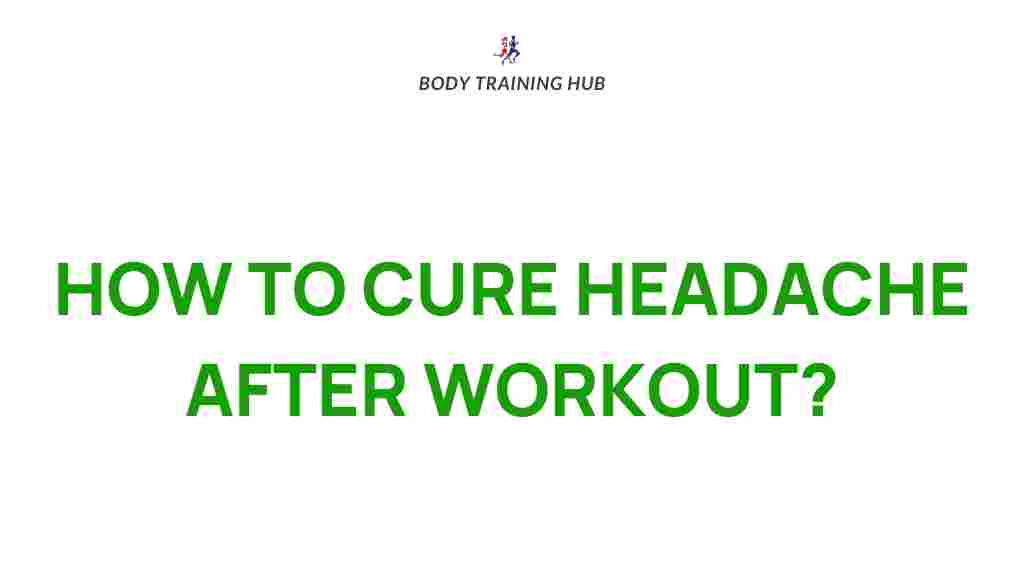Headache: Understanding the Causes Behind Post-Exercise Pain
Experiencing a headache after a workout can be frustrating and disruptive, especially when exercise is meant to enhance well-being. Understanding why post-exercise headaches occur and learning effective ways to manage them can make a significant difference in maintaining a consistent fitness routine. This comprehensive guide uncovers the secrets to alleviating post-exercise headaches, helping you continue enjoying the benefits of exercise without the unwelcome pain.
Why Do Headaches Occur After Exercise?
Post-exercise headaches, often termed as “exercise headaches,” can stem from a variety of causes. These headaches may range from mild to severe and can occur during or after physical activity. Here are some common reasons why they happen:
- Dehydration: One of the most frequent triggers of exercise-induced headaches. Insufficient water intake leads to reduced blood flow to the brain, causing pain.
- Low Blood Sugar: Skipping meals or not fueling up before exercise can cause blood sugar levels to dip, resulting in a headache.
- Muscle Tension: Straining the neck and shoulder muscles during certain activities can contribute to post-exercise headaches.
- Improper Breathing: Holding your breath or not breathing rhythmically can lead to an increase in intracranial pressure, triggering a headache.
- Environmental Factors: Working out in extreme heat or bright sunlight can induce headaches due to temperature fluctuations and glare.
Tips to Prevent and Alleviate Post-Exercise Headaches
Prevention is key when it comes to minimizing the risk of post-exercise headaches. Here are practical steps to ensure you stay headache-free:
1. Stay Hydrated
Water intake is essential before, during, and after exercise. Ensure you drink enough water throughout the day and during your workouts:
- Drink 8-16 ounces of water about 30 minutes before exercising.
- Sip water during your workout, especially if it lasts longer than 30 minutes.
- Rehydrate after your workout by consuming an electrolyte-rich drink if you’ve sweated profusely.
2. Fuel Up Before Exercise
Eating a balanced meal or snack before your workout helps maintain stable blood sugar levels. Choose a mix of complex carbohydrates and protein such as:
- A banana with peanut butter
- Oatmeal with fruits
- Greek yogurt with a sprinkle of granola
Avoid starting an intense workout on an empty stomach, as this can result in an energy dip and subsequent headache.
3. Warm Up and Cool Down Properly
Skipping warm-up and cool-down sessions can lead to tension headaches. Proper stretching and muscle activation ensure that your body transitions smoothly from rest to activity and back. Incorporate these into your routine:
- Warm-Up: Start with light cardio, such as walking or jumping jacks, followed by dynamic stretches.
- Cool Down: End with gentle stretches targeting the neck, shoulders, and back.
4. Practice Proper Breathing Techniques
Breathing effectively during workouts can prevent unnecessary pressure buildup in your head. Follow these tips:
- Practice deep, diaphragmatic breathing during exercises.
- Synchronize your breath with your movements; for example, inhale before lifting and exhale as you exert effort.
- Take short breaks to reset your breathing during high-intensity sessions.
5. Check Your Posture
Poor posture during certain exercises, especially those involving weights or cardio machines, can trigger neck and head tension. Focus on:
- Keeping your shoulders relaxed and away from your ears.
- Aligning your neck and spine.
- Avoiding overextension or hunching during movements.
6. Manage Environmental Triggers
If you’re prone to headaches from external factors, take these steps:
- Choose a well-ventilated space for indoor workouts.
- Wear a hat or sunglasses if exercising outdoors to reduce glare.
- Avoid working out in extreme temperatures.
Ensure your workout environment is comfortable and conducive to minimizing potential headache triggers.
Troubleshooting Persistent Headaches
If you’ve followed preventive measures and still experience headaches after exercising, consider these troubleshooting tips:
Identify Your Headache Type
Not all headaches are the same. Determining the type can help with targeted management:
- Primary Exercise Headaches: These are typically benign and triggered solely by physical exertion. They often respond well to hydration and rest.
- Secondary Exercise Headaches: Caused by underlying conditions, such as sinus issues or hypertension. If headaches persist, consult a healthcare professional for further investigation.
Consider Supplementation
In some cases, supplementing with specific vitamins and minerals can help reduce the frequency of exercise-induced headaches:
- Magnesium: Known for its muscle-relaxing properties, magnesium can help reduce tension headaches.
- Riboflavin (Vitamin B2): Studies suggest it may reduce the frequency and intensity of headaches when taken consistently.
Consult your doctor before starting any supplementation to ensure it’s safe for your specific needs.
Monitor Your Triggers
Keeping a headache journal can be an effective way to identify patterns and triggers. Note the following details:
- Time and duration of the headache
- Type and intensity of the workout
- Food and hydration intake
- Environmental conditions
When to Seek Medical Attention
While most exercise-induced headaches are harmless, certain red flags warrant a visit to your doctor:
- Sudden and severe headache (a potential sign of a serious issue)
- Headache accompanied by nausea, vomiting, or vision changes
- Persistent headaches despite preventive measures
If these symptoms occur, seek professional advice to rule out any underlying health conditions.
Conclusion
Experiencing a headache after exercise doesn’t have to be a regular part of your fitness journey. By understanding potential causes and implementing these strategies, you can prevent and alleviate post-exercise headaches effectively. Prioritize hydration, proper nutrition, and posture, while paying attention to your breathing and environmental factors.
Remember, each individual is different, so finding what works for you is key. For more insights on maintaining a healthy exercise routine, check out our guide to optimizing workout recovery. If you need more comprehensive resources, refer to expert advice from reliable sources like Mayo Clinic.
This article is in the category Strength & Recovery and created by BodyTraining Team
